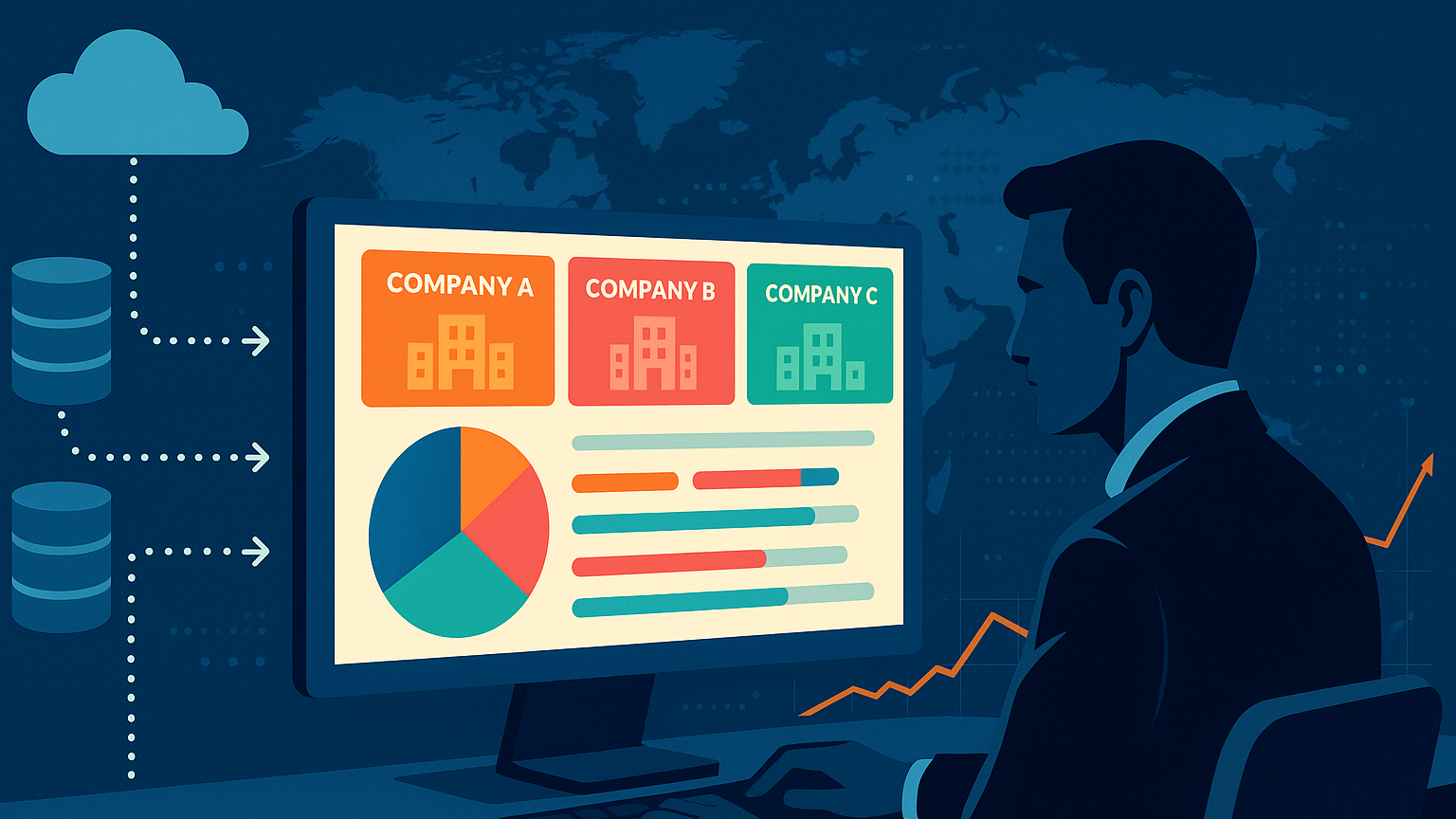
AI Powered Market Segmentation Analysis for Firmographic Insight
You want segmentation that actually moves the needle — not just neat clusters in a report. When you focus on firmographic segmentation powered by AI, you unlock a way to group companies not just by obvious labels like industry or size, but by patterns that predict how they buy, grow, and fit your product. This article walks you through why firmographic insight still matters, how AI changes the way you create and act on segments, which data to use, which algorithms and workflows perform best, and how to measure the impact on revenue, pipeline, and strategy. Throughout, you’ll find practical advice you can apply whether you run sales, lead a GTM team, develop product roadmap, or sit in strategy and business development.

Why Firmographic Segmentation Still Matters
You might feel inundated by customer-level behavior data, but firmographics remain a foundational layer for any B2B strategy. Firmographic attributes like company size, industry classification, annual revenue, geographic presence, and ownership type give you the context to prioritize accounts, design targeted messaging, and align resources across sales and marketing. Because these attributes are relatively stable and often available at scale, they provide durable levers for segmentation that complement dynamic behavioral data.
How AI Changes Market Segmentation
AI reshapes segmentation by making it faster, more granular, and more predictive. Instead of relying only on deterministic rules (e.g., “target companies with 500+ employees”), you can use AI to discover multi-dimensional segments defined by combinations of firmographic, technographic, and behavioral signals. The result is not just more segments, but segments that better predict outcomes like conversion, average contract value (ACV), and customer lifetime value (LTV).
From Manual Rules to AI Models
You’ve probably created manual segmentation rules based on hunches or executive mandates. AI lets you move from those static rules to models that learn from historical outcomes. These models can reveal non-obvious segment boundaries — for example, a cluster of mid-market technology firms in three adjacent countries that respond best to a localized pricing pilot — and update as new data arrives.
Speed and Scale
AI lets you process millions of company records and refresh segmentation in near real-time. Where manual processes would take weeks of research and spreadsheets, automated pipelines can deliver updated segments daily or weekly, enabling dynamic targeting for campaigns and rapid responses to market shifts.
Predictive vs Descriptive Segmentation
Descriptive segmentation helps you understand what existing clusters look like; predictive segmentation tells you which clusters are likely to do what next. You’ll want both: descriptive for strategy and messaging, and predictive for prioritization and activation. AI provides the tools for both modes, with clustering and dimensionality reduction for description and supervised learning for prediction.

Key Firmographic Variables to Use
When you build firmographic models, choose variables that are stable, meaningful, and available across your addressable market. Core attributes include company size (employees), revenue brackets, industry codes (SIC/NAICS), headquarters location, legal status (public/private), funding stage, growth rate, and number of locations. You’ll also consider ownership type (parent/subsidiary), and whether a company is part of a larger enterprise group. These attributes form the backbone of segmentation and work best when paired with technographic and behavioral signals.
Company Size and Revenue
Company size and revenue are fundamental levers for segmentation because they often correlate with budget, buying committees, and procurement processes. You should be careful with missing or estimated revenue figures; where possible, normalize company size and revenue into consistent bands that reflect your product’s pricing tiers.
Industry and Sub-Industry
Industry classification anchors how you position value. Broad industry buckets are useful for high-level GTM strategy, while sub-industry tags allow you to craft messaging that addresses domain-specific pain points. Consider enriching raw SIC/NAICS codes with your own taxonomy to reflect product-market nuances.
Geographic Footprint
Geography affects regulation, language, sales cycle length, and preferred channels. You should segment by country and region, but also consider multi-location customers and whether a target has a global presence, which influences contract complexity and implementation effort.
Growth and Funding Signals
Growth rate, hiring trends, recent funding rounds, and M&A activity are powerful predictors of short-term buying readiness. AI can ingest time-series indicators like headcount changes or funding events to detect accounts that are suddenly more likely to purchase or expand.

Technology Stack and Vendor Relationships
Technographic signals — which platforms and tools a company uses — often determine integration needs and fit. You’ll get better at cross-sell and upsell when you know a target’s stack. These signals can be a firmographic-like layer when consistently available.
Data Sources and Enrichment
Your models are only as good as the data you feed them. You should combine first-party CRM and engagement data with third-party enrichment to reduce sparsity and increase accuracy. Typical enrichment sources include Clearbit, ZoomInfo, Dun & Bradstreet, LinkedIn, and specialized APIs that provide company profiles, location, technographics, and funding events.
First-party Data
First-party data from your CRM, marketing automation platform, and product analytics is invaluable. It records actual interactions, past purchases, and customer outcomes that you’ll use as ground truth for supervised models. You should prioritize cleaning and standardizing this data before enrichment.
Third-party Enrichment
Third-party sources fill gaps and add scale. They provide attributes like annual revenue, employee counts, industry codes, and technographic footprints that might not be present in your CRM. You’ll need to understand vendor coverage, update frequency, and data lineage to pick the right provider.
Public and Web Data
Public filings, job posting data, and news mentions are rich signals for growth and strategic events. Web scraping and APIs that track hiring trends or press releases can surface accounts showing momentum. Be mindful of legal and ethical considerations when scraping.
APIs and Streaming Feeds
To keep segments fresh, you should build ingestion pipelines that pull updates via APIs or streaming feeds. Real-time enrichment is especially useful for sales triggers and ABM campaigns that require immediate action.

Preparing Your Data for AI
You’ll spend much of your project time cleaning and preparing data, and that’s a good thing because quality here multiplies model effectiveness. Key tasks include deduplication (resolving multiple records for the same company), canonicalization of names and addresses, normalizing numeric ranges (e.g., revenue), handling missing values, and transforming categorical attributes into model-friendly encodings.
Feature Engineering
Feature engineering turns raw attributes into inputs that AI models understand. You’ll create features such as revenue-per-employee, region-coded indicators, industry groupings, tenure since last funding event, and binary flags for technology usage. Thoughtful feature design helps models capture domain knowledge without overfitting to noise.
Dealing with Missing and Noisy Data
Missing data is a fact of life in B2B. You should use a combination of imputation, indicator variables for “unknown,” and conservative default buckets to preserve model robustness. Monitor noise sources — like outdated revenue estimates — and design validation checks to catch anomalies.
Choosing the Right AI Methods
Different algorithmic approaches serve different purposes. You’ll choose unsupervised learning when you need to discover natural groupings, supervised learning when you have outcome labels to predict, and hybrid methods when you want both explainability and performance.
Unsupervised Approaches: Clustering and Embeddings
Clustering algorithms such as K-means, hierarchical clustering, and DBSCAN help you reveal natural segments based purely on firmographic and technographic features. Embedding approaches — for example, representing companies as vectors derived from graph relationships or document embeddings — let you compute similarity at scale and discover nuanced communities.
Supervised Approaches: Scoring and Classification
When you have historical labels like closed-won, churned, or expansion accounts, supervised models (logistic regression, gradient boosting, neural nets) will predict which accounts are most likely to take a desired action. These models power prioritization, lead scoring, and propensity-to-buy segments.
Hybrid and Graph-based Methods
Graph ML and community detection are useful when relationships matter: parent-subsidiary links, partnership networks, or customer-supplier chains. You’ll find patterns that flat feature spaces miss, such as influence propagation across corporate groups. Hybrid pipelines can use graph features as inputs to supervised models for better performance.
Explainability and Interpretability
You need segments that you can act on and explain to stakeholders. Models such as tree-based ensembles with SHAP values or rule-extraction tools let you present why a company belongs to a segment or why it scores highly. Explainability is particularly important for sales adoption and executive buy-in.
Building Segments that Drive Action
Segments should be directly tied to actions you want teams to take: outreach cadence for sales, creative variants for marketing, product packaging for product teams. Building action-oriented segments means translating model outputs into clearly defined audience criteria that show who to target, with what message, and what success looks like.
From Segment Definitions to Playbooks
A segment without a playbook is a nice chart but no revenue. For each segment you define, create a short playbook: target persona(s), value proposition, preferred channels, pricing levers, and expected conversion metrics. Make it easy for sales reps and marketers to apply the segment.
Prioritizing Segments by Impact
Not every segment is equally valuable. Use predicted conversion probability, potential ACV, and strategic fit to rank segments. Start with a few high-impact segments for pilots before expanding to long-tail clusters that might require niche campaigns.
Use Cases Across Functions
Firmographic segmentation powered by AI touches many parts of the organization. You’ll find distinct but related use cases across sales, marketing, product, and strategy teams that can be orchestrated to maximize commercial outcomes.
Sales and Account-Based Marketing
For sales, AI-driven firmographic segments help you implement true account-based strategies by prioritizing accounts most likely to convert or expand. You’ll use segments to allocate SDR outreach, design multi-touch campaigns, and equip account teams with tailored talking points. ABM performance tends to improve when segments are grounded in enriched firmographic reality.
Marketing and Demand Gen
Marketing uses firmographic segments to craft messaging, select channels, and measure campaign effectiveness by cohort. You can A/B test creatives and offers across segments to discover what resonates with enterprise buyers versus emerging companies. Segments also help you manage budget allocation for paid media by focusing spend on the most lucrative audiences.
Product and Pricing
Product teams can use segmentation insight to shape feature roadmaps and packaging. You’ll identify which customer types use certain features, which segments require more integration support, and which are price-sensitive. This drives prioritized development and better monetization strategies.
Strategy and Business Development
Strategy teams use firmographic segments to identify partnership targets, potential M&A candidates, and new vertical expansion opportunities. You’ll also use segmentation to model TAM expansion and to forecast revenue by cohort with more granularity.

Measuring Success and ROI
You’ll need a robust measurement plan so you can iterate and scale the AI-enabled segmentation program. Define core metrics tied to business outcomes: conversion rate lift, average deal size, sales cycle length, win rate, CAC, and LTV. Use controlled experiments to measure uplift and attribute changes to segmentation-driven actions.
A/B Testing and Incrementality
The most persuasive evidence for segmentation programs comes from randomized controlled experiments. You should run A/B or holdout tests where one set of accounts receives the AI-driven segmentation strategy and another receives the standard approach. Measure incremental lift on pipeline creation, win rates, and revenue to quantify ROI.
Operational Metrics and Data Health
Beyond business KPIs, track operational metrics: data coverage, enrichment freshness, model performance (precision/recall), and segment stability. These metrics help you maintain trust in the system and catch drift early.
Integrating with CRM and Go-to-Market Systems
For segmentation to be useful, you’ll integrate outputs into the systems your teams already use: CRM, marketing automation, sales engagement platforms, and analytics dashboards. You want automated syncs of segment membership, confidence scores, and playbook recommendations so reps see actionable guidance in their workflow.
Automation and Orchestration
You should automate the handoff from segment generation to activation. That might involve pushing segment tags to your CRM, triggering nurture sequences for marketing, and creating prioritized task lists for SDRs. Orchestration ensures the model’s intelligence converts into behavior.
Operationalizing and Maintaining Segments
Segmentation is not a one-off project. You’ll need automated pipelines that retrain models, refresh enrichments, detect drift, and recompute segment membership on a cadence that matches your go-to-market speed. Establish an operational owner and a lightweight governance process to approve changes, maintain documentation, and handle exceptions.
Retraining and Monitoring
Models decay as markets change. Set thresholds for model performance that trigger retraining and monitor external signals (e.g., economic indicators) that may necessitate re-segmentation. Keep validation datasets and backtests to confirm improvements before deploying updates.
Versioning and Auditability
You should version your model artifacts and segment definitions so you can reproduce past decisions and explain changes to stakeholders. This provides accountability and helps you understand the impact of incremental model improvements.
Privacy, Ethics, and Compliance
You must treat firmographic and enrichment data with care. Even though firmographic data is often business-facing, privacy and compliance rules (like GDPR, CCPA, and local data protection laws) still matter, especially when personal data about contacts is involved. Use data minimization, honor opt-outs, and ensure vendor contracts address lawful processing.
Ethical Considerations
Avoid embedding discriminatory or biased signals into your segmentation — for instance, over-weighting proxies that correlate with protected attributes. You should test models for disparate impact and design mitigation strategies to prevent unfair targeting or exclusion.
Common Pitfalls and How to Avoid Them
You’ll run into common traps like over-segmentation, quality-chasing (building elaborate models on noisy data), and creating segments that are difficult to operationalize. Avoid these by starting simple, validating with experiments, and insisting that every segment corresponds to a clear action and owner.
Overfitting and Complexity
Complex models can overfit historical quirks that won’t repeat. Prefer parsimonious models that generalize and are explainable. Keep a strong validation regime and prefer ensembles that are robust to noise.
Organizational Buy-in
Without clear adoption plans and training, even the best segments will sit unused. Invest time in building playbooks, training reps, and embedding segment signals into daily workflows. Early wins from pilots help build momentum.
Tools, Platforms, and Vendors to Consider
There’s no one-size-fits-all tech stack, but you should combine data providers, an analytics or model training environment, and orchestration tools. Typical choices include data enrichment vendors (ZoomInfo, Clearbit, Dun & Bradstreet), cloud platforms and AutoML (AWS SageMaker, GCP Vertex AI, Azure ML), analytics warehouses (Snowflake, BigQuery), and activation platforms (Salesforce, HubSpot, Marketo). Model-serving and monitoring tools such as MLflow, DataDog, or custom pipelines help keep everything production-ready.
Building a Pilot Project
Start with a well-scoped pilot that proves value quickly. Identify a narrow use case (e.g., prioritize accounts for an outbound SDR team in a specific region), assemble the required data, choose a simple model or clustering approach, build a short playbook, and run a controlled experiment for a quarter. Focus your pilot on speed, measurability, and learnings rather than building a full enterprise solution on day one.
Pilot Checklist
Define objective metrics (pipeline created, win-rate lift), secure data access, pick a data enrichment partner if needed, create a minimal scoring or clustering model, prepare CRM integration for activation, and plan the holdout test to demonstrate lift. Keep the stakeholder list tight and ensure commercial leadership is aligned on evaluation criteria.
Scaling from Pilot to Enterprise
Once you’ve demonstrated uplift, scale by standardizing data pipelines, formalizing governance, and expanding to more segments and regions. Invest in infrastructure that supports continuous retraining and low-latency enrichment, and create a cross-functional center of excellence to propagate best practices across sales, marketing, product, and strategy teams.
Organizational Change Management
Scaling requires process changes: new SLA between data and GTM teams, training programs for sales and marketing, and executive dashboards that reflect segment-driven KPIs. You’ll benefit from a champion at the leadership level who can allocate resources and keep initiatives aligned with strategic objectives.
Future Trends in AI-powered Firmographic Segmentation
You should expect several trends to accelerate in the coming years: graph-based models that map corporate ecosystems, multi-modal models that combine text, web signals, and structured data, privacy-preserving techniques like federated learning and differential privacy, and greater integration of causal inference to move beyond correlation toward understanding drivers of behavior. These advances will let you create segments that are more dynamic, more predictive, and more respectful of data constraints.
Final Thoughts
AI-powered firmographic segmentation can transform how you prioritize accounts, personalize outreach, and align product and pricing strategy — but it only delivers when you link model outputs to real commercial plays and measurement. Start small, focus on data quality and explainability, and iterate with rigorous testing. When you marry AI insight with clear operational ownership and activation pathways, you’ll see faster pipeline creation, higher win rates, and better-aligned GTM execution.
